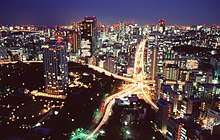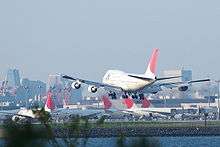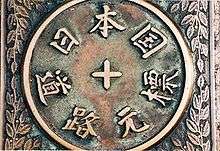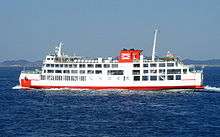Transport in Greater Tokyo

The transport network in Greater Tokyo includes public and private rail and highway networks; airports for international, domestic, and general aviation; buses; motorcycle delivery services, walking, bicycling, and commercial shipping. While the nexus is in the central part of Tokyo, every part of the Greater Tokyo Area has rail or road transport services. The sea and air transport is available from a limited number of ports for the general public.
Public transport within Greater Tokyo is dominated by the world's most extensive urban rail network (as of May 2014, the article Tokyo rail list lists 158 lines, 48 operators, 4,714.5 km of operational track and 2,210 stations [although stations recounted for each operator]) of suburban trains and subways run by a variety of operators, with buses, trams, monorails, and other modes supporting the railway lines. The above figures do not include any Shinkansen services. However, because each operator manages only its own network, the system is managed as a collection of rail networks rather than a single unit. 40 million passengers (counted twice if transferring between operators) use the rail system daily (14.6 billion annually) with the subway representing 22% of that figure with 8.66 million using it daily.[1] There are 0.61 commuter rail stations per square mile in the Tokyo area, or one for each 1.6 square miles of developed land area. Commuter rail ridership is very dense, at 6 million people per line mile annually, with the highest among automotive urban areas.[2] Walking and cycling are much more common than in many cities around the globe. Private automobiles and motorcycles play a secondary role in urban transport.
Air
Since Tokyo region is densely populated, and the country promoted rail travel, air traffic infrastructure had been comparatively underdeveloped. This however has improved somewhat more recently as expansions at the airports, and Haneda had been reinstated for international flights.
Primary airports

Commercial flights in the region are served predominantly by Tokyo International Airport (Haneda) in Ōta, Tokyo (domestic hub for Japan's major airlines) and Narita International Airport in Narita, Chiba (main international gateway airport to the region but has also recently become a new hub for some domestic flights). Service improved to level pre-2011 following expansions but remain congested.
Secondary airports
Chofu Airport in the city of Chōfu in western Tokyo handles commuter flights to the Izu Islands, which are administratively part of Tokyo. Tokyo Heliport in Kōtō serves public-safety and news traffic. In the Izu Islands, Ōshima Airport on Ōshima, Hachijōjima Airport on Hachijō, and Miyakejima Airport on Miyake provide air services.
Ibaraki Airport, located 85 km north of Tokyo, was positioning itself as a hub for low-cost carriers, flights from here to Sapporo seem to be the most popular. Shizuoka Airport, 175 km southwest of Tokyo, aims to be a more convenient alternative for Shizuoka residents than airports in Tokyo or Nagoya, however none of the above airports have shown to take away any significant traffic from Narita or Haneda and continue to play minor roles.
Military
In addition, the Greater Tokyo area has military bases with airfields:
Helipads
There is also a limited number of helicopter transport services in Tokyo, with one service linking Narita airport with central Tokyo.[3]
Rail
Overview
Statistical Profile
Rail is the primary mode of transport in Tokyo. Greater Tokyo has the most extensive urban railway network and the most used in the world with 40 million passengers (transfers between networks tallied twice) in the metro area daily, out of a metro population of 36 million.[1] There are 882 interconnected rail stations in the Tokyo Metropolis, 282 of which are Subway stations,[4] with several hundred more in each of the 3 surrounding densely populated suburban prefectures. There are 30 operators running 121 passenger rail lines (102 serving Tokyo and 19 more serving Greater Tokyo but not Tokyo's city center itself), excluding about 12 cable cars.
Features
The urban rail system in Tokyo does not behave like a single unified network but as separately owned and operated systems with varing degrees of interconnectivity. Expansion continues, albeit with more service and grade separation upgrades as opposed to new lines. Each of the region's rail companies tends to display only its own maps, with key transfer points highlighted, ignoring the rest of the metro area's network. Trains had historically been extremely crowded at peak travel times, with people being pushed into trains by so-called oshiya ("pushers"), which was common in the boom eras of the 1960s-1980s. Most lines in Tokyo are privately owned, funded and operated, though the Toei Subway is run directly by the Tokyo Metropolitan Government and Tokyo Metro is owned/funded indirectly by the Tokyo and national governments. Extensive through services for seamless interconnections between certain lines are also a feature of the network: the Narita-Haneda service run integrates track of 6 separate and independent operators. Rail and subway lines are highly integrated with frequent and high capacity commuter trains from the suburbs continue directly into the subway network to serve central Tokyo, often emerging on the other side of the city to serve another company's surface commuter lines. Shinjuku Station is the busiest train station in the world by passenger throughput.[5] Tokyo's railways tend to shut down at around midnight, with stations themselves closed up around 1am.
Corporate networks
Since corporations own, fund, promote, and operate their own networks, this tends to result in high fragmentation and company stations. The end user may need to pass through multiple company gates to get to their destination, racking up extra costs in the process (generally the longer the trip, the less charge per kilometer). This is in contrast to other nations where fares are calculated in a more integrated way. For tourists, transferring between multiple operators and paying several times to get to a single destination within the metro area can be quite confusing and expensive. Locals tend to patronize a particular company for a particular destination and walk/bike to and from that company's stations, avoiding the need transfer and pay another fare to a different company that may have a station closer to the desired destination.
Busiest JR stations
Passengers carried in Greater Tokyo stations daily (2017):[6]
- Shinjuku Station 778,618
- Ikebukuro Station 566,516
- Tokyo Station 452,549
- Yokohama Station 420,192
- Shinagawa Station 378,566
- Shibuya Station 370,669
- Shimbashi Station 277,404
- Omiya Station 255,147
- Akihabara Station 250,251
- Kita-Senju Station 217,838
Japan Rail
East Japan Railway Company, or JR East, is the largest passenger railway company in the world. It operates trains throughout the Greater Tokyo area (as well as the rest of northeastern Honshū).
In addition to operating some long-haul shinkansen ("bullet train") lines, JR East operates Tokyo's largest commuter railway network. This network includes the Yamanote Line, which encircles the center of Tokyo; the Keihin-Tōhoku Line between Saitama and Yokohama; the Utsunomiya Line (part of the Tōhoku Main Line) to Saitama and beyond; the Chūō Line to western Tokyo; the Sōbu Line, Chūō-Sōbu Line and Keiyō Line to Chiba; and the Yokohama, Tōkaidō, and Yokosuka lines to Kanagawa.
Many additional lines form a network outside the center of the city, allowing inter-suburban travel. Among these are the Hachikō, Itsukaichi, Jōban, Jōetsu, Kawagoe, Musashino, Ōme, Negishi, Nambu, Sagami, Takasaki, and Tsurumi lines. In total, JR alone operates 23 lines within the Greater Tokyo area.
JR East is also the majority shareholder in the Tokyo Monorail, one of the world's most commercially successful monorail lines.
Other railway operators serving Greater Tokyo

Regional railways transport commuters from the suburbs to central Tokyo. These include several private railway networks that own and operate a total of 55 lines serving Tokyo. These same operators indirectly operate another 24 lines outside of Tokyo as well as a few tourist-oriented aerial lifts and funiculars.
- Keihin Electric Express Railway (Keikyu): Operates out of Shinagawa Station to Kanagawa and Haneda Airport. Five lines.
- Keio Corporation: Operates out of Shinjuku Station and Shibuya Station to western Tokyo. Six lines.
- Keisei Electric Railway: Operates out of Keisei Ueno Station to Chiba (including Narita International Airport). Seven lines.
- Odakyu Electric Railway: Operates out of Shinjuku Station to Kanagawa, most notably Odawara and Hakone. Three lines.
- Seibu Railway: Operates out of Seibu Shinjuku Station and Ikebukuro Station to western Tokyo. Thirteen lines.
- Tobu Railway: Operates out of Ikebukuro Station and Asakusa Station to Saitama, Gunma, and Tochigi. Twelve lines.
- Tokyu Corporation (Tokyu): Operates out of Shibuya Station and Meguro Station to southern Tokyo and Yokohama. Eight lines.
- Metropolitan Intercity Railway Company (Tsukuba Express or TX): Links Akihabara Station with Tsukuba. One line.
Some private and public carriers operate within the boundaries of Tokyo.
- Tama Toshi Monorail: A suburban transit line running north/south through Western Tokyo.
- Tokyo Monorail: Connects central Tokyo to Haneda Airport.
- Tokyo Waterfront Area Rapid Transit: Operates the Rinkai Line along the Tokyo waterfront to Odaiba.
- Yurikamome: People mover serving the Tokyo waterfront and Odaiba.
Subway operators

Two organizations operate the Tokyo subway network with several other operators in the metropolitan area that operate lines that can be classified as rapid transit:
- Tokyo Metro (formerly Eidan): Operates Tokyo's (and Japan's) largest subway network, with nine lines.
- Tokyo Metropolitan Bureau of Transportation: Operates the four Toei Subway lines as well as the following:
- Toden Arakawa Line: Once a common sight before subways and buses came to fore, the streetcar network has shrunk to only this one route between Waseda Station and Minowabashi Station.
- Nippori-Toneri Liner: People mover in northeast Tokyo owned and operated by the Tokyo Metropolitan Bureau of Transportation.
- Ueno Zoo Monorail — Short monorail in Ueno Zoo.
- Yokohama Municipal Subway: Owned and operated by the Yokohama city government with two lines.
- Toyo Rapid Railway: A mostly underground line that acts as an extension of the Tokyo Metro Tōzai Line connecting Funabashi and Yachiyo, Chiba.
- Saitama Rapid Railway: An underground line that acts as an extension of the Tokyo Metro Namboku Line connecting southern Saitama to Tokyo.
- Rinkai Line: A mostly underground line that serves Tokyo's waterfront.
Other railway operators of Greater Tokyo
Railway companies that serve other parts of Greater Tokyo include:
- Chiba Urban Monorail: Serving the city of Chiba.
- Disney Resort Line: A monorail that links Maihama Station and Tokyo Disney Resort.
- Enoshima Electric Railway (Enoden): Scenic rail line running between Kamakura and Fujisawa in southern Kanagawa.
- Hokuso Railway: Northeast Chiba Prefecture.
- Sagami Railway (Sotetsu): Serves eastern Kanagawa. Three lines.
- Saitama New Urban Transit (New Shuttle): A people mover in central Saitama.
- Kanazawa Seaside Line: People mover in southern Yokohama.
- Shibayama Railway: A short railway line in northern Chiba.
- Shin-Keisei Electric Railway: A commuter line in northwest Chiba.
- Shonan Monorail: A monorail connecting Ofuna Station to the Shonan coast.
- Ryutetsu: A short line railway in Nagareyama, Chiba.
- Yamaman Yukarigaoka Line: A people mover in Sakura, Chiba.
- Yokohama Minatomirai Railway (Minatomirai Line and Kodomo-no-Kuni Line): Owns two lines in Yokohama; operations are subcontracted to Tokyu Corporation.
Ridership
Below is the annual ridership of each major operator as of the 2010 fiscal year.[7] Transfers between operators are not counted unless they pass through a ticketing gate (not simply a platform).
| Operator | Daily ridership | Annual ridership |
|---|---|---|
| East Japan Railway Company | 15,286,392 | 5,579,533,080 |
| Tokyo Metro | 6,307,390 | 2,302,197,350 |
| Tōkyū Corporation | 2,855,974 | 1,042,430,510 |
| Tōbu Railway | 2,364,626 | 863,088,490 |
| Toei Subway | 2,325,117 | 848,667,705 |
| Odakyū Electric Railway | 1,946,313 | 710,404,245 |
| Keio Corporation | 1,727,355 | 630,484,575 |
| Seibu Railway | 1,692,523 | 617,770,895 |
| Keihin Electric Railway (Keikyu) | 1,207,565 | 440,761,225 |
| Keisei Electric Railway | 712,426 | 260,035,490 |
| Sagami Railway | 623,500 | 227,577,500 |
| Total | 37,049,181 | 13,522,951,065 |
Buses and trams
Public buses in Greater Tokyo usually serve a secondary role, feeding bus passengers to and from train stations. Exceptions are long distance bus services, buses in areas poorly served by rail (not many exist), and airport bus services for people with luggage. Tokyo Metropolitan Bureau of Transportation operates Toei buses mainly within the 23 special wards while private bus companies (mostly the subsidiaries of the large train operators listed above) operate other bus routes, as do other city governments, such as Kawasaki City Bus, Yokohama City Bus, etc. Toei buses have a fixed fare of 210 yen[8] per ride, while most other companies charge according to distance. Some train operators offer combined bus/train tickets; special fares apply for children, seniors and the disabled. Some routes feature non-step buses with a kneeling function to assist mobility-impaired users.[9]
Tokyo Toden, Tokyo's tram network, previously boasted 41 routes with 213 kilometers of track. Now Tokyo has one tram line and one light rail line.
Taxis

Taxis also serve a similar role to buses, supplementing the rail system, especially after midnight when most rail lines cease to operate. People moving around the city on business often choose taxis for convenience, as do people setting out in small groups.
As of December 2007, taxis cost ¥710 (~$7.89 at ¥90/$1 USD) for the first two kilometers, and ¥90 for every 288 meters thereafter, or approximately ¥312.5 per kilometer. Most companies tend to raise fares by 20% between 22:00-5:00, but other companies have kept fares low to compete in a crowded market.[10][11]
Roads

Local and regional highways
National, prefectural and metropolitan, and local roads crisscross the region. Some of the major national highways are:
- Route 1 links Tokyo to Osaka along the old Tōkaidō
- Route 6 and Route 4 carries traffic north all the way to Sendai and Aomori respectively.
- Route 14 connects Nihonbashi with Chiba Prefecture.
- Route 16 is a heavily travelled circumferential linking Yokosuka, Yokohama, western Tokyo, Saitama, and Chiba.
- Route 17 originates in central Tokyo and passes through Saitama en route to Niigata Prefecture.
- Route 20 crosses Tokyo from east to west, continuing into Yamanashi Prefecture.
The datum from which distances are reckoned is in Nihonbashi.
Expressways
The Shuto Expressway network covers central Tokyo, linking the intercity expressways together, while primarily serving commuters and truck traffic. The Bayshore Route bypasses Tokyo by traveling from Kanagawa Prefecture in between, above, and under manmade islands around Tokyo Bay to Chiba Prefecture. The Tokyo Bay Aqua-Line, which goes underneath Tokyo Bay, links Kawasaki to Kisarazu in Chiba Prefecture. Important regional expressways include the Tokyo Gaikan Expressway, Daisan-Keihin Road, and Keiyō Road. Presently under construction (with some segments operating), the Ken-Ō Expressway will be a major circumferential through the area.
Many long-distance expressway routes converge at Tokyo including the Tōmei Expressway, Chūō Expressway, Kan-Etsu Expressway, and Tōhoku Expressway.
Private/Commercial autos
Private and commercial automobiles account are owned by fewer individuals than in other parts of the country. Tokyo, with a population of over 13 million, in 2014 registered a bit less than 4 million vehicles. Tokyo's average car size is larger than the rest of the country, with only 20.1% being kei cars. However it has followed the national trend of kei car popularity increasing almost every year.[12] Kanagawa prefecture also followed a similar trend but to a lower degree, the other two suburban prefectures were similar to the national averages. This is in contrast to Okinawa (opposite extreme in Japan), where there are almost as many registered vehicles as people, however 55.7% were kei cars in 2014.[12]
Maritime transport
Passenger ferries

The notable route which serves as internal transport is Tokyo-Wan Ferry, the car-passenger ferry route between Yokosuka, Kanagawa and Futtsu, Chiba,[13] crossing Tokyo Bay. Other passenger services within the bay are mostly used as scenic cruises, such as Tokyo Cruise Ship and Tokyo Mizube Line in Tokyo, The Port Service and Keihin Ferry Boat in Yokohama.
Out of the bay, the car-passenger ferries to the Izu Islands and the Ogasawara Islands, Shikoku, Kyūshū, the Amami Islands and Okinawa serve from the ports of Tokyo or Yokohama.[14] The car-passenger ferries to Hokkaidō serve from Ōarai, Ibaraki.[14] There are some other freight ferries (which can carry less than 13 passengers) serving out of the Bay.
Shipping
Shipping plays a crucial role for inbound and outbound freight, both domestic and international. The Port of Tokyo and Port of Yokohama are both major ports for Japan and Greater Tokyo.
Other modes
Greater Tokyo is little different from the rest of Japan in the other modes of transport. Greater Tokyo is home to the majority of Japan's automated bicycle systems. Greater Tokyo has a number of bicycle sharing systems.
See also
References
- 1 2 http://www.mlit.go.jp/kisha/kisha07/01/010330_3/01.pdf
- ↑ "Urban Transport Factbook, Tokyo-Yokohama Suburban Rail Summary" (PDF). publicpurpose.com.
- ↑ http://search.japantimes.co.jp/cgi-bin/nn20090314f1.html
- ↑ There are 0.61 commuter rail stations in the Tokyo area per square mile (one for each 1.6 square miles) of developed land area, combined with the high density connecting bus networks, Commuter rail ridership is very dense, at 6 million people per line mile annually, with the highest among automotive urban areas. Urban Transport Factbook, Tokyo-Yokohama Suburban Rail Summary
- ↑ According to the Shinjuku Station article, the station was used by an average of 3.64 million people per day in 2007. It is registered with Guinness World Records.
- ↑ "各駅の乗車人員 2016年度 ベスト100:JR東日本". www.jreast.co.jp.
- ↑ Daily Average Ridership in 2010 Train Media (sourced from JR East) Retrieved June 1, 2012.
- ↑ "Toei Transportation Information: Operations". metro.tokyo.jp.
- ↑ Toei Bus official website: 50% of buses are now non-step buses.
- ↑ http://www.zimbio.com/Japan/articles/707/Taxi+fares+get+first+price+hike+Tokyo+Kanagawa
- ↑ "Tokyo". Mapcarta.
- 1 2 http://www.zenkeijikyo.or.jp/topics/1412fukyuu.html(社団法人全国軽自動車協会連合会 2015年7月6日)
- ↑ ja:東京湾フェリー as of 2007-08-01T09:48 retrieved on 2007-09-07.
- 1 2 ja:日本のフェリー会社一覧 as of 2007-09-05T13:17 retrieved on 2007-09-07.
External links
- JR East official website, showing the map of the Suica/PASMO accepting area, which roughly corresponds with Greater Tokyo Area (in Japanese)
- Greater Tōkyō Railway Network, unofficial railway map of Greater Tokyo (in English)
- Tokyo Railway Map, bilingual railway map of central Tokyo (in Japanese) (in English)

